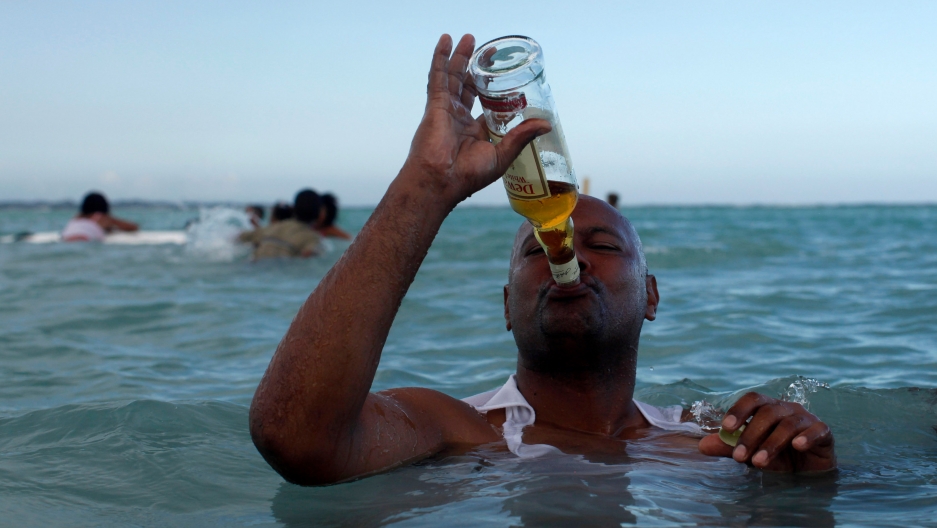non human misbehaviour
NAVIGATE DOWN
CATEGORIESNAVIGATE DOWN
NEWSLETTERSNAVIGATE DOWN
https://www.pri.org/sections/health
Counterfeit alcohol, sometimes containing jet fuel or embalming fluid, is a growing concern for tourists abroad
The Conversation
July 11, 2019 · 3:00 PM EDT
By
Monica H. Swahn
A man drinks whiskey from the bottle while in the sea at a beach in Boca Chica, Dominican Republic, May 17, 2010.
Credit:
Eduardo Munoz/ReutersThe news about the tragic
deaths of several American tourists in the Dominican Republic in May 2019 has created an outcry and a media frenzy. As of June 30, there were at least
nine deaths with similar circumstances in the past few months. The FBI and Dominican authorities are
investigating, and one
theory is that
alcohol was the cause of these deaths.
The FBI has reportedly taken samples of alcohol for
testing, and the hotels where some tourists died have
removed alcohol from the minibars in the hotel rooms. But the concerns are growing, and
Sen. Chuck Schumer (D-NY) on June 30, 2019, recommended that the Bureau of Alcohol, Tobacco, Firearms and Explosives and the Centers for Disease Control and Prevention should aid the ongoing investigation.
Related: Finland's change in alcohol policy puts it out of step with other Nordic countries
Many may find it puzzling that alcohol, particularly adulterated or counterfeit alcohol, could possibly have caused these deaths. But some experts seem to agree that the symptoms and circumstances
fit the indicators of deathscaused by
adulterated alcohol.
As a professor of public health, I need to note that research now shows that
no amount of alcohol is considered safe in terms of your health, and that
alcohol is linked to many cancers and heart disease and is also a key contributor to traffic crashes, violence and suicide. Even so, counterfeit or illegally made alcohol brings a new level of risk, as it is not monitored for safety and may include added ingredients, such as
methanol, known to be extremely harmful to health.
Fake, illegal and adulterated
Thanks to rigorous regulation of alcohol, Americans may not see or hear much about counterfeit alcohol in the
US, but in many other parts of the world counterfeit or “illegal” alcohol is more common and a growing
public health concern.
Counterfeit or illegal alcohol is part of a larger category described as “unrecorded” alcohol because it is not recorded in official statistics and not monitored for quality or for taxation. The
World Health Organization estimates that 25% of the alcohol consumed worldwide is unrecorded.
Related: Libyans risk poisoning for a sip of illegal hooch in their dry nation
Counterfeit alcohol is typically meant to resemble legitimate alcohol, such as finer wines and expensive spirits, in terms of its look, taste and packaging. But there are also other types of alcohol that are typically considered illegal, such as
“moonshine” or “bootleg” alcohol, or simply alcohol that is made under less rigorous processes and that have added ingredients to make the alcohol faster or cheaper.
One of the key aspects of counterfeit or illegal alcohol is that producers distill the alcohol more cheaply and quickly using dangerous shortcuts in the process, such as adding water and
methanol, also known as methyl alcohol, which is highly
toxic. Methanol is not intended for human consumption and can cause liver damage, blindness and death if consumed. Earlier this year, toxic alcohol killed at least
154 people in India because it was tainted with methanol.
Alcohol that has special ingredients added is usually described as adulterated alcohol. Sometimes, those who make counterfeit alcohol will add ingredients not only to make it cheaper but also to improve the taste or strengthen the high. The added ingredients may vary.
For example, in Kenya, one of the popular illegally brewed types of alcohol is called
Chang-aa or “Kill me quick.” That is because it usually has a very high alcohol concentration and is often also
adulterated with harmful ingredients such as pilfered jet fuel or spiked with embalming fluid from mortuaries. This type of alcohol is usually consumed in the
urban slums among those vulnerable and poor who want the cheapest type of alcohol with the biggest “high.”
Si
- Don’t drink homemade or counterfeit “booze.”
- Don’t overdo it.
- Don’t compete with locals and their brew.
- Don’t let your drink out of sight.
Also, there are some
tips for spotting fake alcohol by the Trading Standards Institute in the UK. It is key to remember to pay attention to the place, price, packaging and product, the group says. Most importantly, if the alcohol tastes or smells bad, don’t drink it.
The medical and public health community is growing more concerned about the dangerous effects of alcohol, as new research shows that there is
no safe amount of alcohol. That said, if you choose to drink, especially while abroad, make sure the alcohol you drink is the real thing, and keep it shaken or stirred, but not poisoned.
Monica H. Swahn is a professor of epidemiology and public health at Georgia State University.
Counterfeit alcohol, sometimes containing jet fuel or embalming fluid, is a growing concern for tourists abroad



































